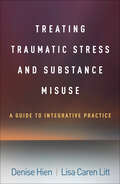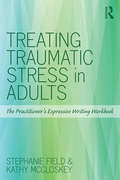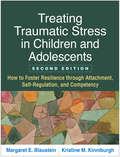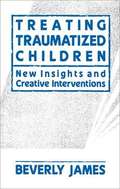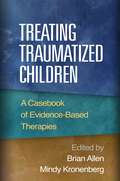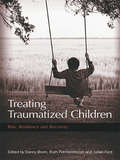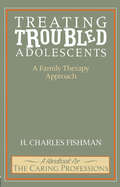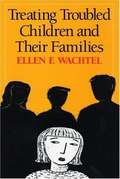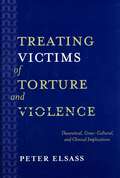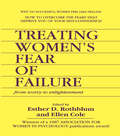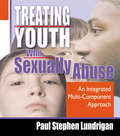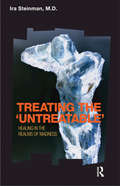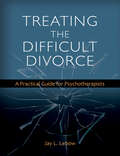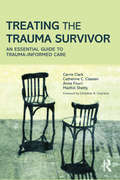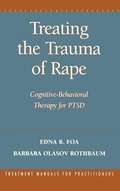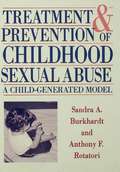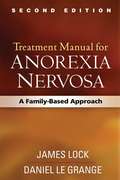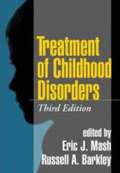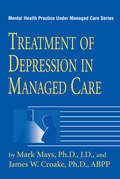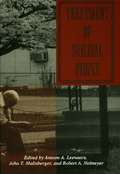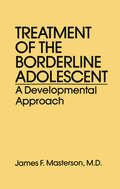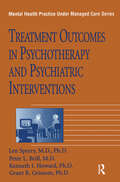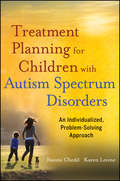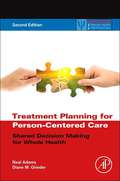- Table View
- List View
Treating Traumatic Stress and Substance Misuse: A Guide to Integrative Practice
by Denise Hien Lisa Caren LittFrom pioneering clinician-researchers, this book provides crucial guidance for treating co-occurring concerns that virtually all therapists are likely to encounter--and many feel ill equipped to handle. Denise Hien and Lisa Caren Litt review the landscape of evidence-based treatments for posttraumatic stress disorder (PTSD), other trauma-related problems, and substance misuse, and present an integrative, culturally responsive framework for assessment and treatment planning. The book shows the clinician how to navigate the complexities of the treatment process while tailoring interventions flexibly and collaboratively to each client's needs. Rich clinical examples include two extended cases that run throughout the chapters. The companion website features several reproducible clinical tools and a comprehensive resource list.
Treating Traumatic Stress in Adults: The Practitioner’s Expressive Writing Workbook
by Stephanie Field Kathy McCloskeyTreating Traumatic Stress in Adults is a resource for therapists of all disciplines for use in the treatment of adults suffering from post-traumatic stress. By reading this unique synthesization of information on the most current trauma treatments and expressive writing exercises, practitioners will gain an integrative and practical set of tools for treating post-traumatic stress. Also included are numerous diverse case vignettes, exercises for building trust in the patient/client relationship, and sections dedicated to exploring the client’s thought patterns and emotions to provide an opportunity for exposure, healing, and restructuring maladaptive beliefs.
Treating Traumatic Stress in Children and Adolescents, Second Edition: How to Foster Resilience through Attachment, Self-Regulation, and Competency
by Margaret E. Blaustein Kristine M. KinniburghTens of thousands of clinicians have used this book--now revised and expanded with 50% new material--to plan and organize effective interventions for children and adolescents who have experienced complex trauma, as well as their parents and other caregivers. The Attachment, Regulation, and Competency (ARC) framework can be used in a wide range of settings to strengthen child–caregiver relationships and support healthy development and positive functioning. Packed with case vignettes and user-friendly clinical tools, the volume identifies key treatment goals and provides flexible intervention strategies and skills. In a large-size format with lay-flat binding for easy photocopying, the book includes 79 reproducible handouts and forms. Purchasers get access to a Web page where they can download and print the reproducible materials. New to This Edition *Reflects the ongoing development of ARC, including important refinements to foundational strategies and treatment targets. *More than 30 additional handouts and worksheets; all reproducible tools are now downloadable. *Greater attention to caregiver skill development throughout. *Addresses ways ARC is being used in nontraditional settings (schools, day care, primary care practices) as well as diverse clinical contexts. See also Treating Adult Survivors of Childhood Emotional Abuse and Neglect, by Elizabeth K. Hopper, Frances K. Grossman, Joseph Spinazzola, and Marla Zucker, which presents a complementary approach also developed at The Trauma Center at Justice Resource Institute.
Treating Traumatized Children
by Beverly JamesListening to a small child describe a parent's murder can tax the most seasoned professional. Cases of physical and sexual abuse where trauma was deliberately inflicted can particularly challenge a practitioner's defenses. Treating Traumatized Children's the first handbook to provide specific guidance and tools for treating children who have been traumatized by physical and sexual abuse, disaster, divorce, or witnessing violent events. This book will provide helping professionals with a clear blueprint for assessing the impact of trauma and developing specific treatment plans. Beverly James, a specialist in evaluating and treating traumatized children, outlines creative exercises and techniques that will enable clinicians to join with children in slowly and carefully reviewing their experiences and helping them understand and accept their feelings related to the trauma. Art, play, and drama techniques, among others, are presented in a sophisticated yet straightforward style, useful to clinicians with specialized training in such techniques or those using them for the first time.
Treating Traumatized Children
by Brian Allen Mindy KronenbergFeaturing extensive case studies, this volume provides a unique window into implementation of evidence-based treatments in real-world community settings. Experienced therapists illustrate the use of three effective therapies for traumatized children and their caregivers: trauma-focused cognitive-behavioral therapy (TF-CBT), child-parent psychotherapy (CPP), and parent-child interaction therapy (PCIT). Covering the entire process of assessment and intervention, the cases highlight ways to maintain treatment fidelity while addressing complex clinical challenges with diverse clients. Experts in the respective therapy models offer instructive commentaries at the end of each case. The book also provides a concise introduction to each model, including its theoretical underpinnings, empirical support, and applications.
Treating Traumatized Children: Risk, Resilience and Recovery
by Julian D. Ford Danny Brom Ruth Pat-HorenczykWhile recent years have seen a vast increase in the literature on adult trauma, interest in childhood trauma has only recently started to gain momentum, encouraging new research and evidence-based interventions. Here the editors have brought together an international list of contributors to look at both innovative and established treatments of trauma in a range of contexts, and provide up-to-date coverage of what is on offer in prevention, assessment, treatment and research. Divided into three parts, main topics discussed are: risk and protective factors for the development of post-traumatic disorders conceptualizations of resilience and suggestions for making them operational evidence-based treatment models for traumatized children Treating Traumatized Children provides professionals with an up-to-date international perspective on the subject, as well as helping professionals and researchers develop future treatments based on current evidence.
Treating Troubled Adolescents: A Family Therapy Approach
by H. Charles FishmanFirst Published in 2017. Routledge is an imprint of Taylor & Francis, an Informa company.
Treating Troubled Children and their Families
by Ellen F. WachtelIntegrating systemic, psychodynamic, and cognitive-behavioral perspectives, this acclaimed book presents an innovative framework for therapeutic work. Ellen Wachtel shows how parents and children all too often get entangled in patterns that cause grief to both generations, and demonstrates how to help bring about change with a combination of family-focused and child-focused interventions. Vivid case examples illustrate creative ways to engage young children in family sessions and conduct complementary sessions with children and parents alone, using a variety of strengths-based, developmentally informed strategies. The paperback edition features a new preface in which the author reflects on the continuing evolution of her approach.
Treating Victims of Torture and Violence: Theoretical Cross-Cultural, and Clinical Implications
by Peter ElsassTorture is among the most disturbing and psychologically devastating of human behaviors. It dehumanizes its victims, leaving them with serious and lasting psychological wounds. Like other psychological trauma, torture frequently leaves in its wake denial and silence among both perpetrators and their victims. This communicative void creates a public and mental block that can make treatment of torture survivors very difficult. Treating Victims of Torture and Violence is the definitive manual for therapists treating victims of torture, prisoners of war, and casualties of forced migration. Divided into five sections dealing with basic concepts of torture--violence and aggression, the torture syndrome, psychotherapeutic treatment, the cultural psychology of torture syndrome, and cultural psychological treatment-- Treating Victims of Torture and Violence employs both classic psychoanalytic and cognitive- behavioral methods. Realizing that torture victims are frequently from different cultures than those of their therapists, Peter Elsass provides in-depth aid to therapists dealing with a multicultural clientele.
Treating Women's Fear of Failure: From Worry to Enlightenment
by Ellen Cole Esther D RothblumThis new book looks at an important issue--the emotional impact of success upon women--at a time when opportunities are more available to them than ever before. Using research, clinical experience, and personal anecdotes, the contributors examine the timely issues of women and worry, women's sense of their own entitlement, fear of success and fear of failure, and women's impostor feelings. The dilemma that feminist therapists frequently experience of encouraging women clients, often superbly qualified in their fields, to take a risk that might involve rejection or failure, is highlighted here. Therapists will recognize the often expressed fears of academic and intellectual failure, as well as the fears of various interpersonal failures that result from a combination of women's opportunities in society as well as socialization.
Treating Youth Who Sexually Abuse: An Integrated Multi-Component Approach
by Stephen LundriganA comprehensive program of treatment for adolescent sex offenders! Covering every phase from assessment to relapse prevention, this valuable book offers specific suggestions and backs them with the latest research as well as years of clinical experience. Treating Youth Who Sexually Abuse: An Integrated Multicomponent Approach is a training tool, reference book, and field manual for the use of therapists, administrators, and everyone involved with the assessment, treatment, and placement of sexually abusive youth. Beginning with a broad view of the continuum of programs available and the structure of the service-delivery system that provides treatment, Treating Youth Who Sexually Abuse continues with specifics of program policy and design in both outpatient and inpatient settings. From choice of client to aftercare, the book covers the specifics of pretreatment, various modalities of therapy, inpatient and outpatient programs, and relapse-prevention programs. The foundations of program structure and the specific components (such as family therapy, group therapy, milieu treatment) are integrated to make a powerful, flexible, and above all effective treatment tool. Treating Youth Who Sexually Abuse offers practical advice and help for therapists and administrators, including: ready-to-use treatment materials reproducible group curricula sample schedules for full-day treatment and afterschool programs discussions of staff training and administrative concerns information on liability issues ideas for coordinating care with other treatment providersTreating Youth Who Sexually Abuse: An Integrated Multicomponent Approach is an essential training tool for students, a field manual for professionals, and a reference book for everyone interested in sex offence-specific treatment for youth. With case studies, diagnostic criteria, helpful tables and diagrams, listings of organizations in the field and Web addresses, this volume deserves a permanent place on your professional bookshelf.
Treating the 'Untreatable': Healing in the Realms of Madness
by Ira SteinmanTreating the 'Untreatable' offers the hope of recovery, healing and cure for the most severe psychotic disturbances, schizophrenia and delusional disorder. Through a psychotherapeutic exploration of hallucinations, delusions and thought disorder, even the most hopeless and "untreatable" patients have a chance for returning to a life of relationships and function even after years, if not decades, of disturbance. These studies in the intensive psychotherapy of schizophrenia and delusional disorders demonstrate that recovery, healing and cure can be achieved in those most disturbed. In this era of treating schizophrenic and delusional patients with a primarily antipsychotic drug oriented approach, a more thorough exploration of the meaning to the patient of his psychosis - with judicious antipsychotic use, when indicated - leads to internal character and external behavioral change that is far more lasting than with antipsychotic use alone. With such a psychodynamic approach, some of these previously chaotic, disturbed and heavily medicated people were able to understand the symbolism and the origin of their psychotic productions and go off antipsychotic medication altogether.
Treating the Difficult Divorce: A Practical Guide for Psychotherapists
by Jay L. Lebow PhDThis book presents a comprehensive, integrative, systemic approach to psychotherapy with families undergoing difficult divorce. Divorce can be an exceptional challenge for couples and children who must endure acrimony, accusations, fear and anxiety for the future. Divorce is also a substantial challenge for mental health professionals, as standard psychotherapeutic approaches can prove insufficient for the complexities of families in crisis. Drawing on the integrative tradition that considers both individual and systemic processes, as well as his nearly forty years of clinical practice, Dr. Lebow describes strategies for intervention that show therapists how to calm individuals, couples, and families in acute distress, and help ease the transition to a new family structure. Chapters highlight the research on divorce and mental health, describe concrete interventions that achieve realistic treatment goals, explain how therapists interact with the legal system in divorce cases, and offer adaptations for different types of divorce, including high-conflict and more normative divorces. This book can be used by one or more therapists, working with couples, a parent and child, a former partner, or even a single parent or child.
Treating the Trauma Survivor: An Essential Guide to Trauma-Informed Care
by Carrie Clark Catherine C. Classen Anne Fourt Maithili ShettyTreating the Trauma Survivor is a practical guide to assist mental health, health care, and social service providers in providing trauma-informed care. This resource provides essential information in order to understand the impacts of trauma by summarizing key literature in an easily accessible and user-friendly format. Providers will be able to identify common pitfalls and avoid re- traumatizing survivors during interactions. Based on the authors’ extensive experience and interactions with trauma survivors, the book provides a trauma-informed framework and offers practical tools to enhance collaboration with survivors and promote a safer helping environment. Mental health providers in health care, community, and addictions settings as well as health care providers and community workers will find the framework and the practical suggestions in this book informative and useful.
Treating the Trauma of Rape: Cognitive-behavioral Therapy for PTSD
by Edna B. Foa Barbara Olasov RothbaumIn the U. S. alone, approximately 1. 5 million adult female survivors of rape are estimated to suffer from chronic PTSD. This invaluable book--informed by the latest research and written by two of the leading authorities in the field--provides a step-by-step guide to proven brief therapy techniques for treating traumatized women. Filling an urgent need of front-line practitioners working within managed care guidelines, the book includes numerous case examples illustrating sensitive and effective information-gathering and intervention, as well as explanations of how to cope with common problems and complications in treatment.
Treatment And Prevention Of Childhood Sexual Abuse
by Anthony F. Rotatori Sandra A. BurkhardtFirst published in 1995. Routledge is an imprint of Taylor & Francis, an informa company.
Treatment Manual for Anorexia Nervosa, Second Edition
by Daniel Le Grange James LockThis indispensable manual presents the leading empirically supported treatment approach for adolescents with anorexia nervosa (AN). What sets family-based treatment apart is the central role played by parents and siblings throughout therapy. The book gives practitioners a clear framework for mobilizing parents to promote their child's weight restoration and healthy eating; improving parent & child relationships; and getting adolescent development back on track. Each phase of therapy is described in session-by-session detail. In-depth case illustrations show how to engage clients while flexibly implementing the validated treatment procedures. New to This Edition Reflects the latest knowledge on AN and its treatment, including additional research supporting the approach. More user friendly clarifies key concepts and techniques. Chapter on emerging directions in training and treatment dissemination. Many new clinical strategies.
Treatment Of Childhood Disorders
by Russell A. Barkley Eric J. MashThis major professional reference and text offers an authoritative review of evidence-based treatments for the most prevalent child and adolescent problems. Leading contributors present applications for anxiety disorders, depressive disorders, ADHD, autistic spectrum disorders, learning disabilities, the effects of maltreatment, substance use, and more.
Treatment Of Depression In Managed Care (Mental Health Practice Under Managed Care Ser. #No.7)
by Mark Mays James W. CroakePublished in 1997, Treatment of Depression in Managed Care is a valuable contribution to the field of Psychiatry/Clinical Psychology.
Treatment Of Suicidal People (Series in Death, Dying, and Bereavement)
by Robert A. Neimeyer Antoon A. Leenaars John T. MaltsbergerTreatment of suicidal people takes three forms: prevention - strategies to avert conditions leading to suicide; intervention - treatment and care during the crisis; and postvention - response after the event has occurred. Unlike other current literature, here the focus is on the state of the art of intervention. This type of examination is essential, because suicidal people themselves are in need of such treatments - crisis intervention, psychotherapy, psychopharmacology and hospitalization. Written by professionals in the field, the Treatment of Suicidal People allows readers to participate in a learning experience. First is a case presentation of an individual - Arthur Inman - and his long road toward suicide, as chronicled in his personal diary. The seond section puts forth guidelines for the evaluation of suicide risk and crisis intervention. A focus on more sustained efforts in psychotherapy is next, a theme which is continued in the fourth part by addressing psychiatric issues that are essential for treatment of highly disturbed and lethal patients. The following section examines a number of clinical and legal issues that transcend any one population of suicidal people, and any particular treatment approach or context. And lastly, the volume returns to Arthur Inman, with case consultations providing alternative perspectives and recommendations on his treatment. Suicide and related forms of self-injurious behaviour can be circumvented, if the involved professionals are sufficiently trained in assessment and prevention.
Treatment Of The Borderline Adolescent: A Developmental Approach
by James F. Masterson, M.D.First published in 1986. Routledge is an imprint of Taylor & Francis, an informa company.
Treatment Outcomes In Psychotherapy And Psychiatric Interventions (Brunner/mazel Mental Health Practice Under Managed Care Ser. #Vol. 6)
by Len Sperry Peter L. Brill Kenneth I. Howard Grant R. GrissomPublished in 1996, Treatment Outcomes in Psychotherapy and Psychiatric Interventions is a valuable contribution to the field of Psychiatry/Clinical Psychology
Treatment Planning For Children With Autism Spectrum Disorders
by Karen Levine Naomi CheddA new way of thinking about treatment planning to support children with autism spectrum disorders Grounded in solid theory, Treatment Planning for Children with Autism Spectrum Disorders: An Individualized, Problem-Solving Approachhelps educators and therapists who work with children with autism spectrum disorders make sense of this confusing, often conflicting, and rapidly evolving clinical and research treatment landscape. Rooted in evidence-based practices, Chedd and Levine provide a 7-step dynamic treatment planning process. The book shows how a variety of current interventions and treatments can be incorporated into this process and includes applications of different approaches for tackling different problems. The nine illustrative case vignettes cover a wide variety of ages, developmental challenges, learning and social profiles, and school and family circumstances. With a firm commitment to and focus on the child's best interests as well as family needs and preferences, Treatment Planning for Children with Autism Spectrum Disorders offers professionals new possibilities for enhancing the quality of life for children with ASDs.
Treatment Planning for Person-Centered Care: Shared Decision Making for Whole Health
by Neal Adams Diane M. GriederThis book guides therapists in how to engage clients in building and enacting collaborative treatment plans that result in better outcomes.
Treatment Planning for Psychotherapists
by Richard B. MakoverThis popular book offers a straightforward, practical method of organizing a treatment plan. It emphasizes a top-down, results-oriented approach that begins with the proposed outcome and then selects the objectives and methods to reach it. <p><p>In this revised edition, Dr. Makover describes a new, simplified system that uses the initial assessment to formulate a case. The formulation then becomes the foundation of treatment decisions. Clinical cases offer clear examples of the planning process. Individual chapters deal with the therapeutic alliance and the treatment contract, how to measure progress, when to end treatment, the treatment impasse, overcoming common challenges, dealing with difficult patients, and how to handle third party requirements. <p><p>Additional learning ideas include suggestions for further skill development and a list of recommended readings. Written in an easy-to-read format, this book will help both the beginner and the experienced therapist become more effective, flexible and successful in the art of psychotherapy.
